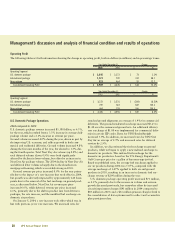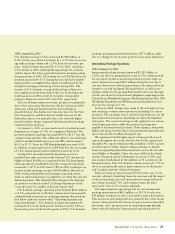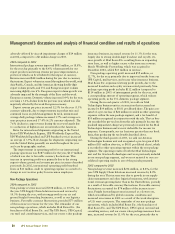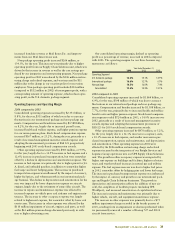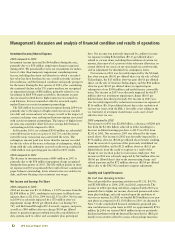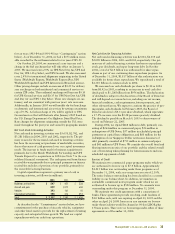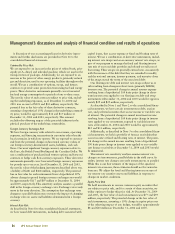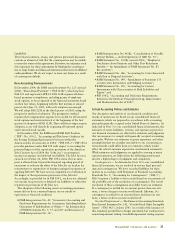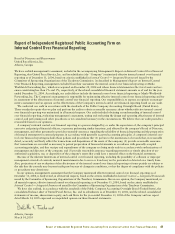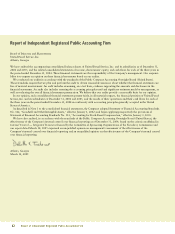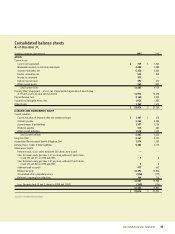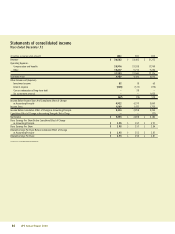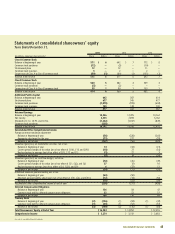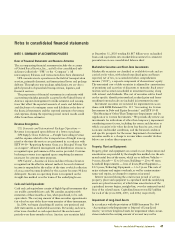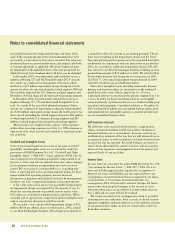UPS 2004 Annual Report Download - page 40
Download and view the complete annual report
Please find page 40 of the 2004 UPS annual report below. You can navigate through the pages in the report by either clicking on the pages listed below, or by using the keyword search tool below to find specific information within the annual report.
38 UPS Annual Report 2004
Management’s discussion and analysis of financial condition and results of operations
that we estimate the fair value of our goodwill and compare that
estimate to the amount of goodwill recorded on our balance
sheet. The estimation of fair value requires that we make judg-
ments concerning future cash flows and appropriate discount
rates. Our estimate of the fair value of goodwill could change
over time based on a variety of factors, including the actual
operating performance of the underlying reporting units. Upon
adoption of FAS 142, we recorded a non-cash impairment charge
of $72 million ($0.06 per diluted share), as of January 1, 2002,
related to our Mail Technologies business. The primary factor
resulting in the impairment charge was the lower than antici-
pated growth experienced in the expedited mail delivery
business. In conjunction with our annual test of goodwill in
2002, we recorded an additional impairment charge of $2 mil-
lion related to our Mail Technologies business, resulting in total
goodwill impairment of $74 million for 2002. Our annual
impairment tests performed in 2003 and 2004 resulted in no
goodwill impairment. As of December 31, 2004, our recorded
goodwill was $1.255 billion.
Self-Insurance Accruals — We self-insure costs associated
with workers’ compensation claims, automotive liability, health
and welfare, and general business liabilities, up to certain limits.
Insurance reserves are established for estimates of the loss that
we will ultimately incur on reported claims, as well as estimates
of claims that have been incurred but not yet reported. Recorded
balances are based on reserve levels determined by outside actu-
aries, who incorporate historical loss experience and judgments
about the present and expected levels of cost per claim. Trends
in actual experience are a significant factor in the determination
of such reserves. We believe our estimated reserves for such
claims are adequate, but actual experience in claim frequency
and/or severity could materially differ from our estimates and
affect our results of operations.
Pension and Postretirement Medical Benefits — The
Company’s pension and other postretirement benefit costs are
calculated using various actuarial assumptions and methodolo-
gies as prescribed by Statement of Financial Accounting
Standards No. 87, “Employers’ Accounting for Pensions” and
Statement of Financial Accounting Standards No. 106,
“Employers’ Accounting for Postretirement Benefits Other than
Pensions.” These assumptions include discount rates, health care
cost trend rates, inflation, rate of compensation increases,
expected return on plan assets, mortality rates, and other factors.
Actual results that differ from our assumptions are accumulated
and amortized over future periods and, therefore, generally affect
our recognized expense and recorded obligation in such future
periods. We believe that the assumptions utilized in recording the
obligations under our plans are reasonable based on input from
our outside actuaries and other advisors and information as to
historical experience and performance. Differences in actual
experience or changes in assumptions may affect our pension and
other postretirement obligations and future expense.
Financial Instruments — As discussed in Notes 2, 3, 8, and 16
to our consolidated financial statements, and in the “Market
Risk” section of this report, we hold and issue financial instru-
ments that contain elements of market risk. Certain of these
financial instruments are required to be recorded at fair value.
Fair values are based on listed market prices, when such prices
are available. To the extent that listed market prices are not
available, fair value is determined based on other relevant
factors, including dealer price quotations. Certain financial
instruments, including over-the-counter derivative instruments,
are valued using pricing models that consider, among other fac-
tors, contractual and market prices, correlations, time value,
credit spreads, and yield curve volatility factors. Changes in the
fixed income, equity, foreign exchange, and commodity markets
will impact our estimates of fair value in the future, potentially
affecting our results of operations.
Depreciation, Residual Value, and Impairment of Fixed
Assets — As of December 31, 2004, we had approximately $14.0
billion of net fixed assets, the most significant category of which
is aircraft. In accounting for fixed assets, we make estimates
about the expected useful lives and the expected residual values
of the assets, and the potential for impairment based on the fair
values of the assets and the cash flows generated by these assets.
In estimating the lives and expected residual values of air-
craft, we have relied upon actual experience with the same or
similar aircraft types. Subsequent revisions to these estimates
could be caused by changes to our maintenance program,
changes in the utilization of the aircraft, governmental regula-
tions on aging aircraft, and changing market prices of new and
used aircraft of the same or similar types. We periodically evalu-
ate these estimates and assumptions, and adjust the estimates
and assumptions as necessary. Adjustments to the expected lives
and residual values are accounted for on a prospective basis
through depreciation expense.
When appropriate, we evaluate our fixed assets for impair-
ment. Factors that would indicate potential impairment may
include, but are not limited to, a significant change in the extent
to which an asset is utilized, a significant decrease in the market
value of an asset, and operating or cash flow losses associated
with the use of the asset.
In December 2003, we permanently removed from service a
number of Boeing 727 and McDonnell Douglas DC-8 aircraft.
As a result, we conducted an impairment evaluation, which
resulted in a $75 million impairment charge during the fourth
quarter for these aircraft (including the related engines), $69 mil-
lion of which impacted the U.S. domestic package segment and
$6 million of which impacted the international package segment.
In December 2004, we permanently removed from service a
number of Boeing 727, 747 and McDonnell Douglas DC-8 air-


